人教版高二英语必修四unit2Working the Land grammar课件(22张)
文档属性
| 名称 | 人教版高二英语必修四unit2Working the Land grammar课件(22张) | 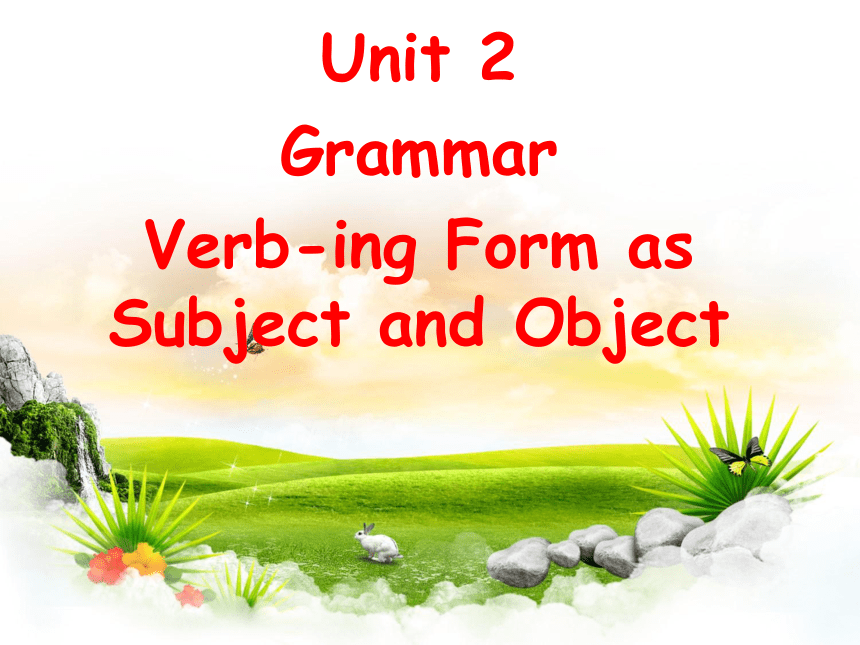 | |
| 格式 | zip | ||
| 文件大小 | 2.6MB | ||
| 资源类型 | 教案 | ||
| 版本资源 | 人教版(新课程标准) | ||
| 科目 | 英语 | ||
| 更新时间 | 2019-06-03 10:18:46 | ||
图片预览

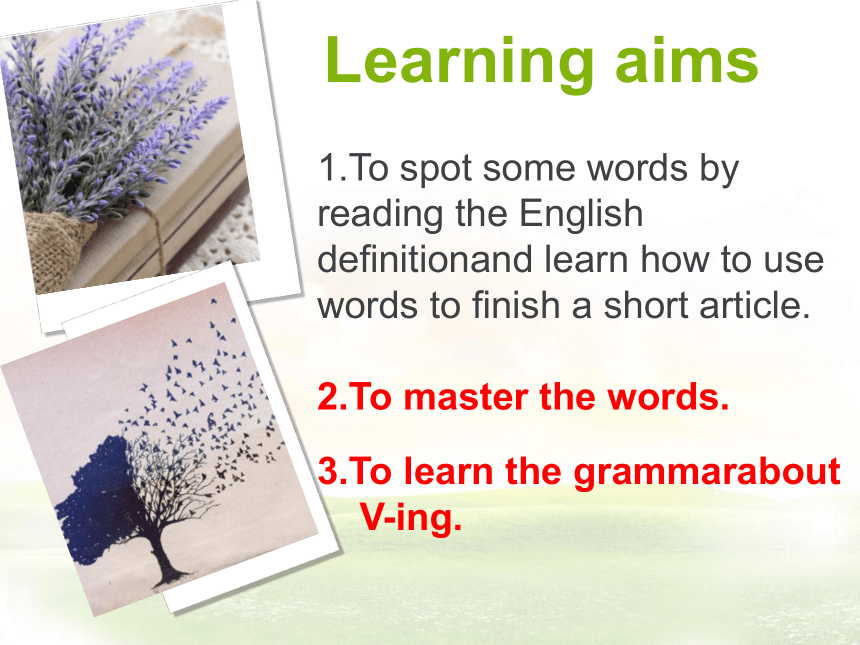
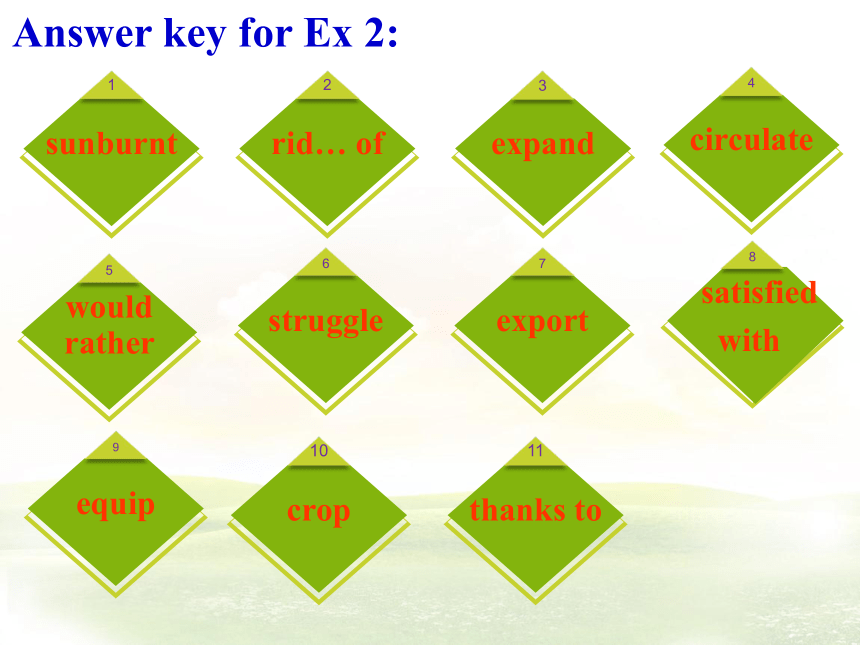
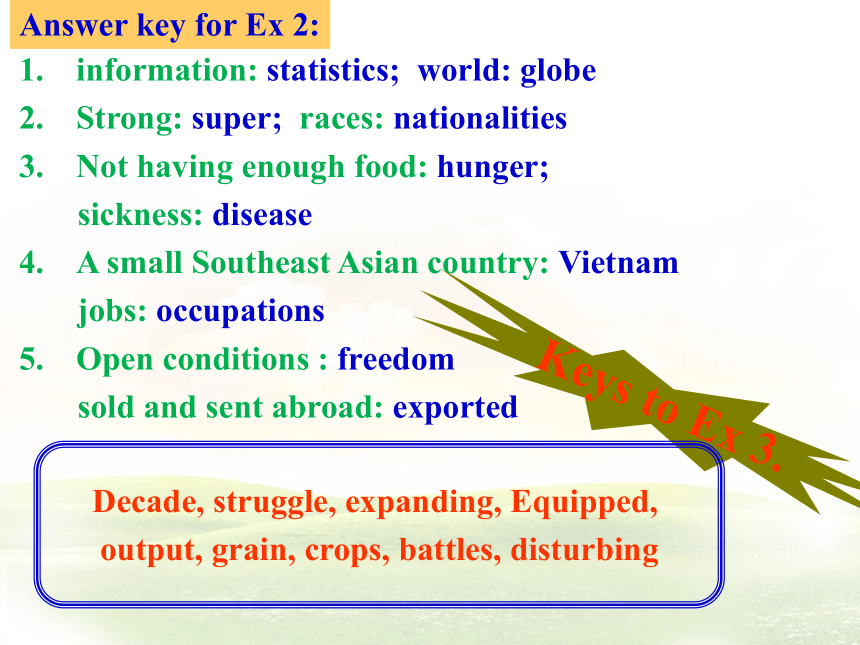
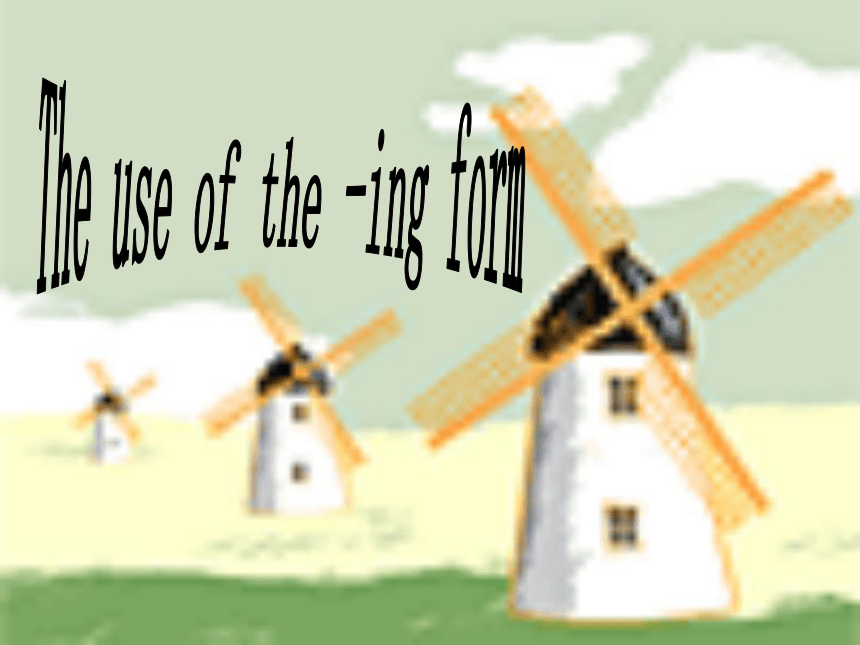
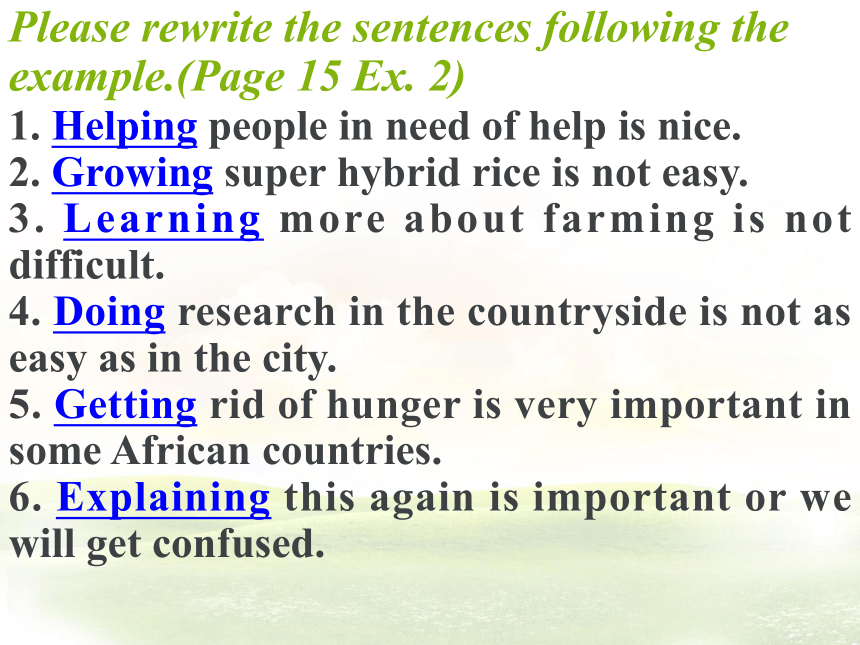


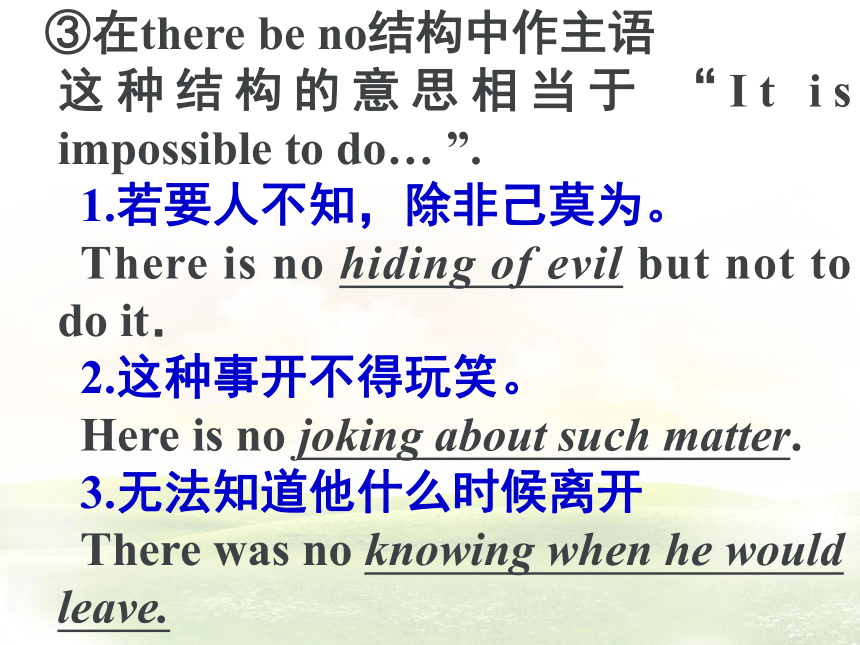
文档简介
Unit 2
Grammar
Verb-ing Form as Subject and Object
Learning aims
1.To spot some words by reading the English definitionand learn how to use words to finish a short article.
2.To master the words.
3.To learn the grammarabout
V-ing.
Answer key for Ex 2:
Answer key for Ex 2:
information: statistics; world: globe
Strong: super; races: nationalities
Not having enough food: hunger;
sickness: disease
A small Southeast Asian country: Vietnam
jobs: occupations
Open conditions : freedom
sold and sent abroad: exported
Keys to Ex 3.
Decade, struggle, expanding, Equipped,
output, grain, crops, battles, disturbing
Please rewrite the sentences following the example.(Page 15 Ex. 2)
1. Helping people in need of help is nice.
2. Growing super hybrid rice is not easy.
3. Learning more about farming is not difficult.
4. Doing research in the countryside is not as easy as in the city.
5. Getting rid of hunger is very important in some African countries.
6. Explaining this again is important or we will get confused.
1. –ing 作主语
①直接置于句首
1) 捉弄别人是我们万万不能干的.
Playing tricks on others is something we should never do.
2)学习新单词对我来说非常重要。
Learning new words is very important for me.
3)说比做容易。
Talking is easier than doing.
②用形式主语it,把真正的主语ing形式移置句尾, 作表语的只能是某些形容词或少数名词。
1.和他争辩是没有什么用的。
It is useless trying to argue with him.
2.这事值得去做。
It’s worth making the effort.
想再解释一次有好处吗?
3.Is it any good trying to explain?
跟你在一起工作是令人愉快的。
4.It is pleasant working with you.
③在there be no结构中作主语 这种结构的意思相当于 “It is impossible to do… ”.
1.若要人不知,除非己莫为。
There is no hiding of evil but not to do it.
2.这种事开不得玩笑。
Here is no joking about such matter.
3.无法知道他什么时候离开
There was no knowing when he would leave.
注意:-ing与不定式的比较:
-ing表示的动作通常是一个泛指的动作,
to do则通常表示具体的动作。
我喜欢看书,但是我现在想看电影。
I like __________, but now I like ____________ .
reading
to see a film
归纳:常用-ing形式作主语的句型有:
It is/ was a waste of time doing
做…是浪费时间的
It is/was no good/use doing
做…是没益/用处的
It is/was hardly/scarcely worth doing
做…不值得
It is/was worth/worthwhile doing
做…是值得的
There is no doing…
无法…,不允许…
There is no sense in doing做…没有道理
There is/was no use doing干…无意义
There is/was nothing worse than doing
没有比…更糟的
There is/was no point doing
干…无意义
1.我们不知道要去哪儿。
There was no knowing where we would go.
2.做这件傻事毫无意义。
There is no point doing such a silly thing.
注意:There is no need to do sth 干…没必要,在此句式中to do 不可换为doing..
1.没有必要告诉她。
There is no need to tell her.
注意:-ing的逻辑主语由形容词性物主代词和名词所有格构成。
2.我姐姐病了,使我很担心。
My sister's being ill made we worried.
3.你正确未必就意味着我错了。
Your being right doesn't necessarily mean my being wrong.
2、-ing 用作宾语
①只能后接动名词作宾语的动词,常见的有avoid, consider, enjoy, keep,finish,suggest,dislike,delay,escape,cannot help,imagine,mind,miss,practise,cannot stand, excuse,fancy,give up,put off,risk等。如:
你是否考虑过找一位挚友?
Have you considered looking for one special friend?
②既可接动名词又可接不定式作宾语的动词,常见的有:begin,start,continue,like,love,prefer,by,mean,forget,remember,hate等。
·A. 在like, love, hate, prefer等动词之后,用-ing或不定式意义上没有什么不同,只是侧重点有些不同,动名词表示泛指的动作,不定式表示具体的一次性动作。
B. 在begin / start, continue之后, 用动名词和不定式, 意义无甚区别, 尤其是当主语是人的时候。
C.在动词forget,remember,regret之后,用动名词与不定式意义不同. 动名词表示动作先于谓语发生, 不定式表示后于谓语动作, 如:
我记得我已把信寄了。
I remember posting the letter.
我会记着去寄信的。
I’ll remember to post the letter.
D.在try,mean之后,意义各不相同,如try to do (设法),try doing (试试),mean to do (打算,有意要做),mean doing (意思是,意味着)。如:
我们必须设法及时把一切搞好。
We must try to get everything done in time.
我们用别的方法做这工作试试。
Let’s try doing the working in some other way.
E·go on doing 和go on to do
go on doing 继续做一直在做的事;
go on to do 接着做另一件事。
stop doing 停止做
stop to do 停下正干的事去干另一件事
请接着做这同一个练习。
Please go on doing the same exercise.
请做另外一个练习。
Please go on to do the other exercise.
3.作介词宾语
下列短语中的to都是介词, 所以后面跟名词或-ing形式:devote to,object to,pay attention to,get down to,lead to, look forward to,stick to,be used to等.
Summary
1.-ing form
2.-ing form as the subject
3.-ing form as the object
Homework
Finish the exercises Section II on Keshi’xunlian.
Thanks for joining us!
Grammar
Verb-ing Form as Subject and Object
Learning aims
1.To spot some words by reading the English definitionand learn how to use words to finish a short article.
2.To master the words.
3.To learn the grammarabout
V-ing.
Answer key for Ex 2:
Answer key for Ex 2:
information: statistics; world: globe
Strong: super; races: nationalities
Not having enough food: hunger;
sickness: disease
A small Southeast Asian country: Vietnam
jobs: occupations
Open conditions : freedom
sold and sent abroad: exported
Keys to Ex 3.
Decade, struggle, expanding, Equipped,
output, grain, crops, battles, disturbing
Please rewrite the sentences following the example.(Page 15 Ex. 2)
1. Helping people in need of help is nice.
2. Growing super hybrid rice is not easy.
3. Learning more about farming is not difficult.
4. Doing research in the countryside is not as easy as in the city.
5. Getting rid of hunger is very important in some African countries.
6. Explaining this again is important or we will get confused.
1. –ing 作主语
①直接置于句首
1) 捉弄别人是我们万万不能干的.
Playing tricks on others is something we should never do.
2)学习新单词对我来说非常重要。
Learning new words is very important for me.
3)说比做容易。
Talking is easier than doing.
②用形式主语it,把真正的主语ing形式移置句尾, 作表语的只能是某些形容词或少数名词。
1.和他争辩是没有什么用的。
It is useless trying to argue with him.
2.这事值得去做。
It’s worth making the effort.
想再解释一次有好处吗?
3.Is it any good trying to explain?
跟你在一起工作是令人愉快的。
4.It is pleasant working with you.
③在there be no结构中作主语 这种结构的意思相当于 “It is impossible to do… ”.
1.若要人不知,除非己莫为。
There is no hiding of evil but not to do it.
2.这种事开不得玩笑。
Here is no joking about such matter.
3.无法知道他什么时候离开
There was no knowing when he would leave.
注意:-ing与不定式的比较:
-ing表示的动作通常是一个泛指的动作,
to do则通常表示具体的动作。
我喜欢看书,但是我现在想看电影。
I like __________, but now I like ____________ .
reading
to see a film
归纳:常用-ing形式作主语的句型有:
It is/ was a waste of time doing
做…是浪费时间的
It is/was no good/use doing
做…是没益/用处的
It is/was hardly/scarcely worth doing
做…不值得
It is/was worth/worthwhile doing
做…是值得的
There is no doing…
无法…,不允许…
There is no sense in doing做…没有道理
There is/was no use doing干…无意义
There is/was nothing worse than doing
没有比…更糟的
There is/was no point doing
干…无意义
1.我们不知道要去哪儿。
There was no knowing where we would go.
2.做这件傻事毫无意义。
There is no point doing such a silly thing.
注意:There is no need to do sth 干…没必要,在此句式中to do 不可换为doing..
1.没有必要告诉她。
There is no need to tell her.
注意:-ing的逻辑主语由形容词性物主代词和名词所有格构成。
2.我姐姐病了,使我很担心。
My sister's being ill made we worried.
3.你正确未必就意味着我错了。
Your being right doesn't necessarily mean my being wrong.
2、-ing 用作宾语
①只能后接动名词作宾语的动词,常见的有avoid, consider, enjoy, keep,finish,suggest,dislike,delay,escape,cannot help,imagine,mind,miss,practise,cannot stand, excuse,fancy,give up,put off,risk等。如:
你是否考虑过找一位挚友?
Have you considered looking for one special friend?
②既可接动名词又可接不定式作宾语的动词,常见的有:begin,start,continue,like,love,prefer,by,mean,forget,remember,hate等。
·A. 在like, love, hate, prefer等动词之后,用-ing或不定式意义上没有什么不同,只是侧重点有些不同,动名词表示泛指的动作,不定式表示具体的一次性动作。
B. 在begin / start, continue之后, 用动名词和不定式, 意义无甚区别, 尤其是当主语是人的时候。
C.在动词forget,remember,regret之后,用动名词与不定式意义不同. 动名词表示动作先于谓语发生, 不定式表示后于谓语动作, 如:
我记得我已把信寄了。
I remember posting the letter.
我会记着去寄信的。
I’ll remember to post the letter.
D.在try,mean之后,意义各不相同,如try to do (设法),try doing (试试),mean to do (打算,有意要做),mean doing (意思是,意味着)。如:
我们必须设法及时把一切搞好。
We must try to get everything done in time.
我们用别的方法做这工作试试。
Let’s try doing the working in some other way.
E·go on doing 和go on to do
go on doing 继续做一直在做的事;
go on to do 接着做另一件事。
stop doing 停止做
stop to do 停下正干的事去干另一件事
请接着做这同一个练习。
Please go on doing the same exercise.
请做另外一个练习。
Please go on to do the other exercise.
3.作介词宾语
下列短语中的to都是介词, 所以后面跟名词或-ing形式:devote to,object to,pay attention to,get down to,lead to, look forward to,stick to,be used to等.
Summary
1.-ing form
2.-ing form as the subject
3.-ing form as the object
Homework
Finish the exercises Section II on Keshi’xunlian.
Thanks for joining us!
同课章节目录
